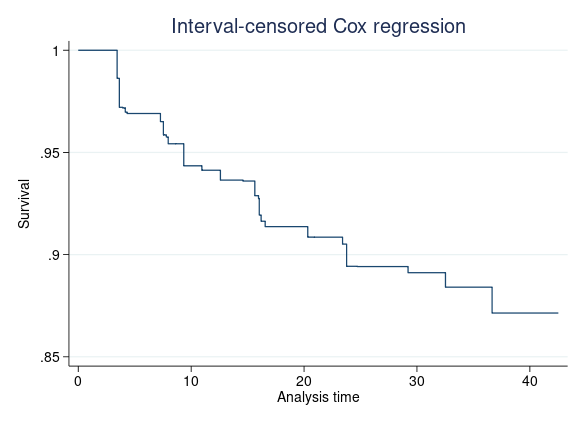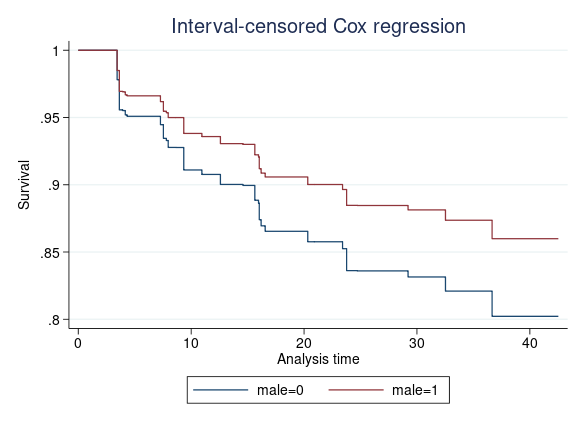New In 
Interval-censored Cox model
Often, time-to-event or failure-time data are collected at particular observation times. But sometimes, the event of interest is not observed exactly but is only known to occur within some time interval. For example, a physician will detect the recurrence of cancer only when the patient comes to the clinic for a follow-up appointment, and an epidemiologist who studies the COVID-19 incubation period will only know the infection occured before the patient shows symptoms or tests positive for COVID-19. In statistics, data like these are called interval-censored event-time data. Interval-censored event-time data arise in many areas, including medical, epidemiological, financial, and sociological studies. Ignoring interval-censoring may lead to biased estimates.
Just like with right-censored data, the Cox proportional hazards model is appealing for interval-censored data because it does not require parameterization of the baseline hazard function, and for low event rates, the exponentiated regression parameters approximate the log relative-risks.
In Stata 17, the new estimation command stintcox fits the semiparametric Cox proportional hazards models to interval-censored event-time data. The command can analyze data that include all types of censoring, including current-status data, in which the event of interest is known to occur only before or after an observed time. It also supports stratification.
Highlights
- Genuine semiparametric modeling
- Current-status and general interval-censored data
- Stratified estimation
- Two estimators for baseline hazard
- Two estimators for standard errors
- Graphs of survivor, cumulative hazard, and hazard functions
- Residual diagnostics
- Graphical checks of proportional-hazards assumption
Let’s see it work
- Estimation
- Graphing survivor functions
- Stratification
- Checking proportional-hazards assumption
- Additional resources
Estimation
We use data from Zeng, Mao, and Lin (2016), who study time to HIV infection in a cohort study of injecting drug users in Thailand. The dataset contains 1,124 subjects. Those subjects initially tested negative for the HIV virus. They were then followed and assessed for HIV-1 seropositivity through blood tests approximately every four months. Because the subjects were tested periodically, the exact time of HIV infection was not observed, but it was known to fall in intervals between blood tests with the lower and upper endpoints recorded in variables ltime and time.
We want to identify the factors that influence time to HIV infection. The factors we are interested in are age at recruitment (age), sex (male), history of needle sharing (needle), history of drug injection (inject), and whether a subject has been in jail at the time of recruitment (jail).
. use https://www.stata-press.com/data/r17/bts
(Bangkok Tenofovir Study (BTS))
. describe
Contains data from https://www.stata-press.com/data/r17/bts.dta
Observations: 1,124 Bangkok Tenofovir Study (BTS)
Variables: 8 15 Dec 2020 13:34
(_dta has notes)
| Variable Storage Display Value | ||||||
| name type format label Variable label | ||||||
| age byte %8.0g Age (in years) | ||||||
| male byte %8.0g yesno Male | ||||||
| needle byte %8.0g yesno Shared needles | ||||||
| jail byte %8.0g yesno Imprisoned | ||||||
| inject byte %8.0g yesno Injected drugs before recruitment | ||||||
| ltime double %10.0g Last time seronegative for HIV-1 | ||||||
| rtime double %10.0g First time seropositive for HIV-1 | ||||||
| age_mean double %10.0g Centered age (in years) | ||||||
We fit a Cox proportional hazards model in which time to HIV infection depends on the above factors of interest. To make the interpretation of the baseline hazard function more reasonable, we will use the centered age variable, age_mean.
. stintcox age_mean i.male i.needle i.inject i.jail, interval(ltime rtime)
note: using adaptive step size to compute derivatives.
Performing EM optimization (showing every 100 iterations):
Iteration 0: log likelihood = -1086.2564
Iteration 100: log likelihood = -597.65634
Iteration 200: log likelihood = -597.57555
Iteration 295: log likelihood = -597.56443
Computing standard errors: ............................ done
Interval-censored Cox regression Number of obs = 1,124
Baseline hazard: Reduced intervals Uncensored = 0
Left-censored = 41
Right-censored = 991
Interval-cens. = 92
Wald chi2(5) = 17.10
Log likelihood = -597.56443 Prob > chi2 = 0.0043
| OPG | ||||||
| Haz. ratio std. err. z P>|z| [95% conf. interval] | ||||||
| age_mean | .9684341 .0126552 -2.45 0.014 .9439452 .9935582 | |||||
| male | ||||||
| Yes | .6846949 .1855907 -1.40 0.162 .4025073 1.164717 | |||||
| needle | ||||||
| Yes | 1.275912 .2279038 1.36 0.173 .8990401 1.810768 | |||||
| inject | ||||||
| Yes | 1.250154 .2414221 1.16 0.248 .8562184 1.825334 | |||||
| jail | ||||||
| Yes | 1.567244 .3473972 2.03 0.043 1.014982 2.419998 | |||||
We find that age at recruitment is associated with lower risk of HIV infection and being in jail at enrollment is associated with higher risk of HIV infection. Other factors are not statistically significant.
Graphing survivor functions
We can graph the baseline survival curve by using stcurve with all covariates set to 0.
. stcurve, survival at((zero) _all)

We can also graph the survivor functions with covariates set to any value. Suppose we want to compare the survivor functions of an average subject in the female and male groups. We type
. stcurve, survival at(male=(0 1))

Stratification
If we assume that the baseline hazard function for female is different from that for male, we can fit a stratified Cox proportional hazards model by using the strata() option:
. stintcox age_mean i.needle i.inject i.jail, interval(ltime rtime) strata(male)
note: using adaptive step size to compute derivatives.
Performing EM optimization (showing every 100 iterations):
Iteration 0: log likelihood = -1087.0536
Iteration 100: log likelihood = -585.59848
Iteration 200: log likelihood = -585.53143
Iteration 282: log likelihood = -585.5222
Computing standard errors: ........................... done
Stratified interval-censored Cox regression
Baseline hazard: Reduced intervals
Strata variable: male Number of obs = 1,124
Uncensored = 0
Left-censored = 41
Right-censored = 991
Interval-cens. = 92
Wald chi2(4) = 14.84
Log likelihood = -585.5222 Prob > chi2 = 0.0051
| OPG | ||||||
| Haz. ratio std. err. z P>|z| [95% conf. interval] | ||||||
| age_mean | .9682508 .0126326 -2.47 0.013 .9438052 .9933295 | |||||
| male | ||||||
| Yes | 1.276222 .2270302 1.37 0.170 .9005422 1.808625 | |||||
| needle | ||||||
| Yes | 1.245357 .2393768 1.14 0.254 .8544367 1.815131 | |||||
| inject | ||||||
| Yes | 1.245357 .2393768 1.14 0.254 .8544367 1.815131 | |||||
| jail | ||||||
| Yes | 1.57314 .3490687 2.04 0.041 1.018337 2.430205 | |||||
Our conclusion here is similar to the case without stratification.
Checking proportional-hazards assumption
It is important to evaluate the validity of the underlying assumption for the Cox proportional hazards model, which is that the hazard ratio is constant over time. Stata 17 provides two new graphical commands to assess the proportional-hazards assumption.
For a single categorical covariate in a Cox model, you can use stintphplot, which plots -ln{-ln(survival)} curves for each category versus ln(analysis time). If the plots are parallel, the proportional-hazards assumption has not been violated. Alternatively, you can use stintcoxnp to plot the nonparametric maximum-likelihood estimation survival curve versus the Cox predicted survival curve for each category. When the two curves are close together, the proportional-hazards assumption is valid.
When a Cox model contains multiple covariates, as mentioned in the above example, only stintphplot is appropriate for testing the proportional-hazards assumption. In that case, we need to use the adjustfor() option.
For example, to check the proportional-hazards assumption for inject, we include all covariates except inject in the adjustfor() option:
. stintphplot, interval(ltime rtime) by(inject) adjustfor(age_mean i.male i.needle i.jail)

A separate Cox model, which contains all covariates from the adjustfor() option, is fit for each level of inject. And the two plots are almost parallel, which indicates that the proportional-hazards assumption has not been violated for the categorical variable inject.
Reference
Zeng, D., L. Mao, and D. Lin. 2016. Maximum likelihood estimation for semiparametric transformation models with interval-censored data. Biometrika 103: 253–271.
